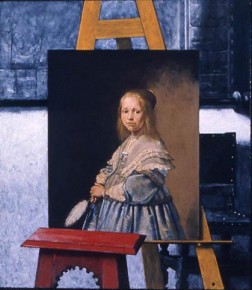Related WorksNo related works found. |
| WorkEasel Painting, Verspronck
| Image Notes
Reference Vermeer, The Art of Painting, 1665-66. Kunsthistorisches Museum, Vienna. Jan Cornelisz Verspronck, Girl in a Blue Dress, 1641. Rijksmuseum, Amsterdam. Alternate title: Dutch Painting on Vermeer's Easel. The photolithographic print made from this painting has the alternate title: Dutch Painting on Vermeer's Easel (Verspronck). Atelier Dumas, New York, 1980, 6 colors, edition 300. Signed and numbered by artist lower right. | Artist's Notes
Working on Easel Painting, Verspronck, I made a new medium: one part stand oil five parts turpentine fifteen drops cobalt drier every ten ounces. Cobalt drier works better than any drier I have used. It turns the medium brown but has no effect on the painting. Using this medium, I apply a thin layer of paint and after it dries I then apply Damar varnish in a very thin mixture, one part Damar varnish, four parts turpentine. ...Working on Easel Painting, Verspronck, and making sense with it. I need a whiter easel and whiter walls in this painting. ...Easel Painting, Verspronck is completed. It has turned out the way it should: very bright, and a bit manipulated. That is what it is about. I signed it, but I am not through looking at it. (George Deem, "Extra Genre," WhiteWalls A Magazine of Writings by Artists #6, Summer 1981. ISSN:0190-9835.
Johannes Verspronck died when Jan Vermeer was thirty years old. Verspronck's "Portrait of a Little Girl" was in the Vermeer house when Verspronck died. Johannes Verspronck 1597-1662 Jan Vermeer 1632-1675 Jan Vermeer's father was a silk weaver. He ran a tavern and dealt in art. The painting "Portrait of a Little Girl" was well known by young Vermeer. I have put Verspronck's "Portrait of a Little Girl" on Vermeer's easel. This easel and stool with map and chair in background are copied from Vermeer's "An Artist in His Studio" (Kunsthistorisches Museum, Vienna). The portrait is simple, even timid in composition: one three-fourths figure with one light source, and the figure happens to be a little girl standing still. This composition has no joints, there is no way to bend nor manipulate anything with the eye. The painting has one note. Any good painting is good first of all because I must go see it again. When I go to see the portrait I do not look for some detail I might have forgotten, but I look at the entire painting and see it physically. It is mere physical pleasure for a painter to see. There is no worry about anything. I see only the way the plot of the paint goes. This is a solo and watching a solo is simple because I don't know what to worry about until the solo is over. An Easel Painting. A painting showing a painting on an easel, the machine which holds the painting while it is being made. Behind Vermeer's yellow easel is the black and white studio, with part of a hanging map and a chair. These articles were not meant to be seen. They are what artists see when they see paintings in studio. I've made the studio black and white so that it appears like polaroid before the light prints it in color. It's also like the part that was under the frame once, so it didn't need to be colored in. The red stool is where the artist sat. It is in the way. It's the orchestra showing parts of instruments over the stage so that the production is alive. The little girl has not done anything. In order to do anything to her I must subtract or add things around her. An easel holds a two-dimensional rectangle (who wants to work with a square?), an empty canvas. The artist makes that two-dimensional rectangle do something. My painting has the two-dimensional canvas finished to begin with. That's how I painted it. What my completed painting does now is make the portrait be something else because it is put in another dimension. It doesn't matter what size the original is, this is a reproduction process to begin with. The planes. In color Easel Painting has four planes. Red (stool), blue (portrait), yellow (easel) and black and white background. The portrait has four planes around it, the four sides. The first plane, the upper plane. If this were a clock, we are looking at 12 o'clock, the plane that is farthest in illusion, the hanging map. It is as good as looking out a window. The next plane going clockwise holds the chair, a crowded-in object to show how far the white wall is behind the easel. The third plane is the lower plane that has the many legs that hold all the props that rig up the composition. The fourth plane, the most important plane (to the left) that introduces the eye to the portrait. (Notebook entry, about 1977) | ExhibitionsSneed Gallery, Rockford, Illinois Allan Stone Gallery, New York |
Works
| WorkEasel Painting, Verspronck
| Image Notes| Artist's Notes| Exhibitions |

